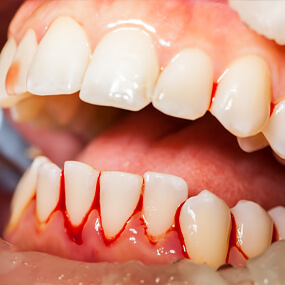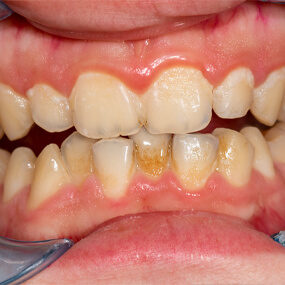Dental Cavities: Types, Prevention and Treatment

All cavities—also known as dental caries—are similar in that they are deterioration of a tooth caused by acids made by oral bacteria. You may think of a cavity as a tiny hole, and while most cavities start out that way, they can vary considerably depending on where the tooth decay is located.
Three Primary Cavity Types
- Smooth-surface cavities happen on the flat areas of your teeth, including between them.
- Pit and fissure cavities occur on biting surfaces and usually of the premolars and molars.
- Root cavities originate on tooth roots, which should be below the gumline.
Smooth-Surface Cavities
Cavities can form on the flat surfaces of the teeth due to plaque. These surfaces include the front, back, and sides. These cavities are the least common, slow to develop, and usually the least severe. Since they are slow to develop, they are often diagnosed early and can even be reversed if caught early enough. Reversal is achieved through remineralization, which can be accomplished through in-office fluoride treatments or, in some cases, various toothpastes and other over-the-counter oral care products.
While it does take a long time for a cavity to erode the enamel on a smooth surface, it will eventually happen, and when it does, the cavity is not reversible, and a filling is required. Some smooth-surface cavities are interproximal cavities—meaning that they occur between the teeth. These can be difficult to detect and often require a dentist to use X-rays in order to identify them.
Pit and Fissure Cavities
The terms pit and fissure refer to the depressions and grooves, respectively, that are found on the chewing surfaces of your teeth. This type of cavity is most common on the premolars and molars because that surface is larger. Food is easily stuck in these pits and fissures, and plaque can accumulate more easily since these teeth are generally the most difficult to brush and floss well.
Dental sealants are a popular option to avoid pit and fissure cavities. A dentist will often place them during adolescence as soon as the permanent premolars and molars arrive, but adults who have become prone to such cavities can get them as well. Caught early enough, pit and fissure cavities can be treated with fluoride or sealants, but if the decay progresses, the decay must be removed. A crown is often necessary in these cases, and if the decay has reached the pulp, then root canal therapy will be required.
Root Cavities
Root cavities occur on tooth roots, which should be protected by the gums. For this reason, root cavities are more common in older adults who have receding gums or other gum disorders. Exposed tooth roots are highly susceptible to decay. They are protected by cementum, which is much weaker than enamel and thus easily compromised by oral bacteria, spreading decay, and even dietary acids.
A dentist will generally treat a root cavity by cleaning out the decay and filling the area with a dental material. If the decay has reached the pulp, root canal therapy will be necessary to save the tooth. In either case, a crown is often required since such decay often compromises the tooth structure. Root cavities should be treated as soon as possible due to how fast this type of decay spreads.
What Are the Treatment Options for Cavities?
The treatment options for cavities have all been touched on above: dental sealants, dental fillings, root canal treatment, and dental crowns. The appropriate treatment will depend on the location and the severity of the decay, and in some cases, your dentist will need to combine these approaches.
- Dental Sealants – A dental sealant is an acrylic type of coating that is essentially painted onto a chewing surface. It bonds into the pits and fissures. It does not smooth them out but rather serves as a protective coating. While sealants are often a preventive measure, they can be used to treat a cavity when caught soon enough.
- Dental Fillings – Dental fillings are among the most common dental procedures, and most people have had at least one during childhood. After the dentist removes the decay, the filling is used to avoid future decay and ideally make the tooth whole. There are various materials that can be used as a filling, including porcelain, composite resin, and gold in some cases.
- Root Canal Treatment – When tooth decay reaches the tooth pulp—which houses nerves and blood vessels—it will become infected. At this point, a dentist must perform root canal therapy, which involves removing the inflamed pulp and all remnants of infection, disinfecting and shaping the canal, and, finally, filling and sealing the cavity. After root canal treatment, a dental crown is often required.
- Dental Crowns – While teeth can usually be saved, they may no longer have enough structure to remain as is without a crown. A dental crown is essentially a cap that goes over the compromised tooth. A crown can restore form as well as function, and your dentist can dictate the shape, size, and color based on your other teeth. In addition to tooth decay, crowns are often used when there has been dental damage or a tooth is otherwise compromised.
Early Diagnosis Is Key
The Centers for Disease Control and Prevention estimates that more than 90 percent of Americans have had a cavity and more than 25 percent have active tooth decay. Visiting your dentist twice a year is crucial because he or she can identify cavities while they are still simple and cheap to fix. It is also very important that you brush and floss your teeth every day to eliminate most plaque and avoid tartar.
Keep Those Cavities Away
Preventing cavities starts at home with regular brushing and flossing. It is also essential that you visit Scottsdale Cosmetic Dentistry Excellence for a cleaning and an exam even when your teeth feel fine. If you have a cavity, schedule an appointment with Jeffrey D. Clark, DDS, right away. Dr. Clark can assess the problem, treat it, and get you back on the path to a healthy mouth. Call us at 480 585 1853 to schedule your appointment.




